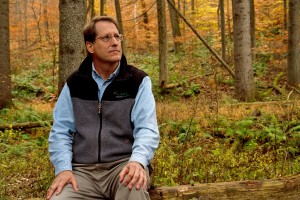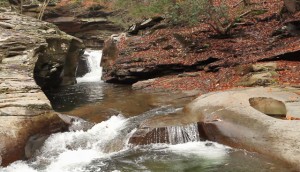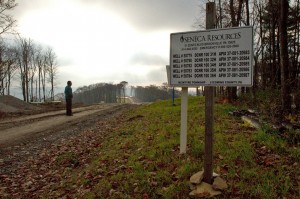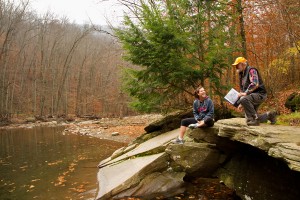Lovers of Pa.’s Loyalsock Forest Fight to Limit Drilling There
-
Susan Phillips

Lindsay Lazarski / WHYY/Newsworks
“We have to be the voice of the birds,” said Paul Zeph, of the Pennsylvania Audubon Society.
Deep in the Loyalsock State Forest, where no cell phone signal reaches, the sounds of rushing waterfalls and forest birds are suddenly interrupted by the sound of a helicopter.
Paul Zeph of the Pennsylvania Audubon Society says the noise could be related to gas drilling. Drillers will often drop seismic testing equipment into remote areas that are difficult to reach by roads. And that leads Zeph to cite one of the many worries that naturalists and outdoors lovers have with plans to expand drilling in the Loyalsock.
“Song birds identify one another through singing and they identify their territory through singing,” says Zeph. “With a very noisy environment, studies are starting to show that it’s impairing the ability to find mates.”

Lindsay Lazarski / WHYY/Newsworks
A waterfall at Rock Run in the Loyalsock Forest. On the rock to the right is a “pothole,” a cylindrical hole created over time by the water.
The Loyalsock State Forest consists of more than 100,000 acres of pristine wilderness 120 miles north of Harrisburg, stretching across Bradford, Lycoming and Sullivan counties. It’s home to black bear, wild turkey, bobcats, native brook trout, and rare and endangered birds. It also sits above some very productive natural gas deposits of the Marcellus Shale.
So the Loyalsock is now the site of a tense three-way dance among energy companies, environmentalists and state regulators over whether, where and how drilling should be allowed in this state forest. Zeph, who has a bird-call app on his phone, says the Loyalsock serves as a nursery for migratory birds that come from the tropics. He says more drilling will fragment the forest, leaving miles of clearings for new roads and pipelines that will welcome bird predators like raccoon, opossums, and bluejays.
“We don’t need to fragment the best quality forest we have in Pennsylvania to heat our homes,” says Zeph. “There are other decisions we can make.”
About two-thirds of Pennsylvania’s state forests sit atop Marcellus Shale natural gas deposits. The state has leased 385,400 acres to drillers, but there’s a moratorium on new leases. Another 290,000 acres, where the state does not own the mineral rights, are currently under development. Cases where ownership of the land surface differs from control of the mineral rights beneath are called “split estates.”
That’s the case with a section of the Loyalsock State Forest known as the “Clarence Moore” tract. Clarence Moore was a speculator who purchased the mineral rights from their original owner, the Central Pennsylvania Lumber Company. His holdings were later transferred to Anadarko Petroleum and Southwestern Energy Company.
These privately held sections of the forest lie beneath some of the most treasured parts of the Loyalsock, including The Old Logger’s Path, Rock Run and Sharp Top Vista. Anadarko’s plans to open up those new forest areas for drilling have brought the three-way tension to a new pitch.
Dick Martin, with the Pennsylvania Forest Coalition, used to teach high school science. His pal Steve Szoke, with the Loyalsock Creek Watershed Association, used to work for Bethlehem Steel. On one beautiful fall day, Martin and Szoke drove to some of their favorite spots in these woods, which are littered with colored flags used by surveyors.

Lindsay Lazarski / WHYY/Newsworks
A stake in the ground marks the preliminary survey of Anadarko Petroleum Corporation for a possible well pad in the Loyalsock State Forest.
“They’re going to be coming in right up here and cutting a new road in,” says Szoke. Szoke is an avid fly-fisherman and hunter. But these days, he and Martin have been doing more than hiking and fishing. They’ve been tracking down surveyor’s tape and flags deep in the forest, where few people ever see. “If you look back there you can see the pink, the red, white and blue,” Szoke said. “The pink lines going through like that are the original survey of the right-of-way.”
The colored flags littering this untouched forest all mark future pieces of natural gas infrastructure: roads, pipelines, well-pads.
Anadarko (click for StateImpact’s map app page on Anadarko wells) and the Department of Conservation and Natural Resources have been negotiating access to the land where Anadarko controls mineral rights. The energy company’s full plan for the Loyalsock acres has not been made public. But State Rep. Greg Vitali, a Delaware County Democrat who chairs the Environmental Resources and Energy Committee, says sources have told him the company plans to construct 25 well pads.
Anadarko owns the natural gas lying beneath about 25,000 acres in the Loyalsock. DCNR says the state maintains “above average” surface rights on about 18,000 of those acres, meaning Anadarko has to negotiate with DCNR for access to drill. But the state says, thanks to past court rulings, the situation is less clear on about 7,000 acres. In those areas, the state says the gas company holds the upper hand.
This helps explain DCNR’s cautious approach, which angers forest-lovers and environmentalists, who want to know more about Anadarko’s plans. But the state faces a dilemma. Limit Anadarko’s access, DCNR says, and the company might sue. Chris Novak, DCNR spokeswoman, says that given the legal uncertainty, the department’s goal is “to keep development out of the most sensitive areas if we should reach a point where we’re required to provide access.”
“It really makes sense to look at what are the most valuable resources ecologically, recreationally,” says Novak, “because there are 200 miles of trails in the Loyalsock. And that’s our job, that’s what we do. We try to balance the different uses of the forest.”
Novak says Anadarko offered the state $15 million dollars for access to drill. The department made a counter offer of $22 million. So far, no agreement has been reached.
Environmentalists say the state shouldn’t be so worried about a lawsuit, that Anadarko’s legal position is not that strong. Ralph Kisberg of Responsible Drilling Alliance says the state needs to play hardball with the gas company over the most sensitive areas of the forest. “Let’s hold some hearings and let people comment,” says Kisberg. “If you’re talking about value, the public owns it and should determine the value here.”
Kisberg says the whole Clarence Moore tract is sensitive and should not be used for gas development.

Lindsay Lazarski / WHYY/Newsworks
A sign post marks some of the natural gas drilling wells from Seneca Resources in the Loyalsock State Forest.
Anadarko Petroleum says its discussions with the state have focused on “the identification and protection of important species and habitat.”
“We recognize the importance of public lands in Pennsylvania,” wrote Anadarko spokeswoman Mary Wolf in an email, “including the Loyalsock State Forest. As with all of our operations on state forest land, we are looking to minimize surface disturbance and protect special places like Rock Run. We will work with [state agencies] to communicate any approved plans as appropriate.”
Drilling in the state forests is not new. It’s been going on since 1947. But the Marcellus Shale boom means a bigger footprint: more and larger well pads, wider pipeline right-of-ways.
Parts of the Loyalsock have already been leased to another gas company, Seneca Resources. That happened during the Rendell Administration.
Seneca spokesman Rob Boulware says drilling in state forests actually gets more scrutiny than drilling on private land, and that his company is committed to minimizing its footprint during active drilling and after wells are completed.
As he drove up to one Seneca well pad at night, bright lights were shining on a bustling industrial operation in the middle of the forest, an eerie, striking tableau. “We don’t have the advantage of daylight to see what it looks like,” Boulware said. “But it’s a beautiful vista and we’ll do the best we can to bring it back in conjunction with DCNR, to reduce this footprint.”
He says once the drilling and fracking are completed, the company will reestablish native vegetation.
These Loyalsock wells are Seneca Resource’s most productive, says Boulware. So the state is benefiting by getting some fat royalty checks. That’s the situation where drillers lease state forest tracts from the state. [For StateImpact’s shale map app page on Seneca, click here.]

Lindsay Lizarski / WHYY/Newsworks
Dick Martin of the Pa. Forest Coalition and Samantha Malone of FracTracker Alliance take in the views at Rock Run in the Loyalsock State Forest.
But in places where the energy company owns the mineral rights, as with the Anadarko tracts, no leases are needed and no royalty checks flow. The state’s leverage consists of using surface rights to control access to the sites.
And Dick Martin, of the Pennsylvania Forest Coalition, is one of many who worries the state is not driving a hard-enough bargain: “Let’s do some really creative horse trading. Let’s try to swap some rights here, where DCNR can protect the most special places. There are special plants, there are rare, endangered birds up here.”
This is why many groups are pushing for a seat at the table as Anadarko and state officials continue their negotiations. DCNR has responded to the public pressure, and says a public meeting on drilling in the Loyalsock will be scheduled for June.


















